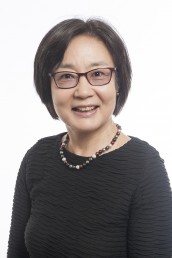Keeping seniors active at home
The University of Illinois at Chicago has received a five-year, $3 million federal grant to see if a physical activity program for home-bound seniors can keep them out of nursing homes.
Studies show that regular physical activity benefits older adults both physically and mentally. However, those who find daily activities like walking and bathing difficult have limited opportunities to be active.

Naoko Muramatsu, associate professor of community health sciences in the UIC School of Public Health
Naoko Muramatsu, associate professor of community health sciences in the UIC School of Public Health, is the principal investigator on the grant from the National Institute on Aging, one of the National Institutes of Health. She believes a sedentary lifestyle poses great risk — and that home-care aides have the potential to promote their client’s physical activity and health, and also keep them safe.
Home care aides, she says, are already working with this vulnerable population and are vastly underappreciated.
“Keeping people healthy and out of nursing homes is one of the most important ways to reduce the burden of caregiving placed on families and lower the cost of health care for older adults,” Muramatsu said.
“We are facing an aging crisis, and the U.S. is behind in preparedness,” said Muramatsu, who is also a fellow in UIC’s Institute for Health Research and Policy. “Already, the cost for long-term care is rising, and in less than 50 years, the number of people over the age of 65 will double. Our social and health care systems need practices and policies that address the unique needs of this growing population.”
The trial aims to see if training home-care aides to deliver a physical activity program called “Healthy Moves for Aging Well” can improve their clients’ physical function and well-being. Healthy Moves includes motivation and three chair-bound movements that target aerobic endurance, strength and flexibility.
Researchers will enroll in the study 300 home-care aides and their clients, who are home-bound people over 60 on Medicaid. Medicaid is the country’s largest payer of long-term care costs.
Participants will be randomly assigned to an intervention group or a control group. Aides in the intervention group will receive training in the Healthy Moves program and introduce the program to their clients. The control group will only provide cognitive activities, such as word-searching, to their clients.
Participants will undergo a baseline assessment and follow-up testing at four and eight months. Testing will include self-reported assessments and standard fitness tests that measure walking speed and the ability to stand up and sit down, for example.
Muramatsu also hopes that the Healthy Moves intervention will also empower home-care aides who themselves are aging.
“Our long-term goal is to develop a sustainable health promotion program that can be used widely by all kinds of people and organizations in community-settings,” Muramatsu said.
Co-investigators on the grant include IHRP researchers Michael L. Berbaum, director of the IHRP Methodology Research Core and adjunct associate professor of epidemiology and biostatistics in the UIC School of Public Health; David X. Marquez, associate professor of kinesiology and nutrition in the UIC School of Applied Health Sciences; and Surrey M. Walton, associate professor of pharmacy systems, outcomes and policy, in the UIC College of Pharmacy.
This study is funded by grant No. R01AG053675 from the National Institute on Aging.
